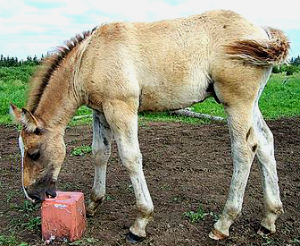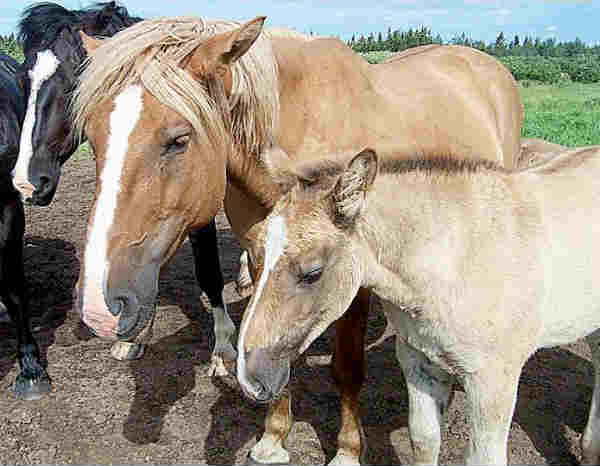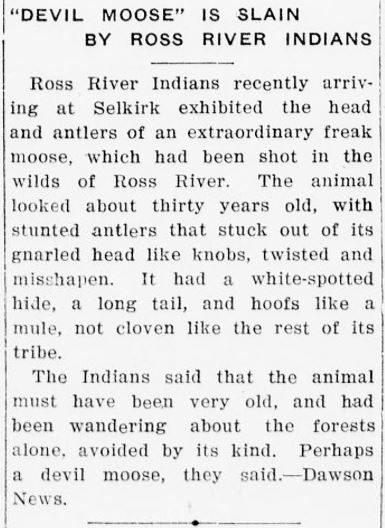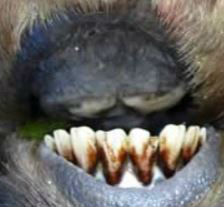Moose-horse Hybrids?
Mammalian Hybrids
This page was a draft for a section of my book on distant hybrids, available here >>
|
A horse is a horse, of course, of course, unless, of course…
(from the “Mr. Ed” song)
|
 Bambi, an alleged moose-horse hybrid. Note the mooselike, down-turned muzzle.
Bambi, an alleged moose-horse hybrid. Note the mooselike, down-turned muzzle.On May 5th, 2006, at Saint-Jogues, Quebec, a community about 20 kilometers north of the coastal town of Paspébiac, a mare foaled a colt (pictured at right) that its owner, François Larocque, insisted was the result a mating with a bull moose.
Larocque claimed the mare in question had no access to a fertile stallion during the time that she would have had to conceive. He also pointed out that her offspring had unusually long legs, long woolly ears, a muzzle that curved downward (as in a moose), and two bumps on its head at the points where antlers might be expected to emerge. So most of the similarity to moose in this animal seems to be from the neck up. As Larocque later told the newspaper Le Soleil: “When the mare gave birth, my sisters said: ‘It has a moose head.’”
This alleged moose-horse hybrid, which Larocque named Bambi, provoked a great deal of discussion. Local biologists and veterinarians were sufficiently intrigued to request that it be genetically tested. However, if such tests occurred, their results seem not to have been made public. Moose have, in fact, been observed mounting mares, but it seems that no actual hybrid of this type has been previously confirmed by genetic testing.
 Bambi, an alleged moose-horse hybrid standing beside her mother.
Bambi, an alleged moose-horse hybrid standing beside her mother.
 Old article about an ostensible moose-horse hybrid. It appeared in the Cordova, Alaska, Daily Times (Nov. 1, 1922, p. 2, col. 2).
Old article about an ostensible moose-horse hybrid. It appeared in the Cordova, Alaska, Daily Times (Nov. 1, 1922, p. 2, col. 2).
According to information on a website forum (see link below), Larocque saw a bull moose prowling the rear of his property during September 2005. Moose come into rut in September. On the same website, it was stated that he owned only two gelded stallions, and that there were no other stallions in the vicinity of Saint-Jogues.
The gestation period of a moose is eight months, that of a horse, eleven. The diploid chromosome number of horses is 2n=64, while that of North American moose is 2n=70.
From the pictures shown here, as well as other photos shown on the Internet, it’s clear that this animal, if it is a hybrid, is much more similar to a horse than to a moose. But the mere fact that horse characters seem to predominate does not in itself preclude the possibility that it is derived from hybridization between horse and moose. It has long been recognized that in certain crosses the hybrids much more closely resemble one parent than the other. As Darwin noted in the Origin of Species, “There are certain hybrids which instead of having, as is usual, an intermediate character between their two parents, always closely resemble one of them.” And such has been my own experience with certain crosses. So it may well be the same with moose-horse hybrids.
 Dental pad of a moose
Dental pad of a moose
Given that moose lack upper incisors and instead have a dental pad as do cows, whereas horses lack a pad and have upper incisors, a simple diagnostic would be to check whether this animal has a dental pad. If so, it would almost certainly be a hybrid.
Read an article about this animal (in French).
Read comments about this animal on a website forum (in French).
The following is a brief account of an alleged moose-horse foaled by a mare. It appeared on page 3 (col. 3) of the September 9, 1913 issue of The Brattleboro Daily Reformer, a newspaper published in Brattleboro, Vermont (Access original).
“MOOSE MARE” WAS A REMARKABLE FREAK
Strangest Equine Produced in New England Had Trotters All Stopped
Sired by Bull Moose
The famous “moose mare” of Maine, so called because her owner believed her to have been sired by a bull moose, was perhaps the most remarkable equine freak that New England has ever known. Her prowess on the track in the forties and fifties was widely known, and horsemen of the period who timed her for exhibition half-mile heats refused to believe their senses when she covered the distance in 1:10 to 1:12 [track times were considerably slower in the 1840s than today].
The animal, a nondescript creature with large, uncouth head, lapping ears and a scant mane, whose tail was a stub hardly larger than a goat’s tail, worked during the forties on a stage and freight team that ran between Jay and Readfield Me.
She was called the “moose mare” because of her resemblance to the monarch of the woods. She was foaled the property of Benjamin Goodnow of Jay from a fine Morgan mare, which he had at pasture the year before the birth of the freak, away from all other horses. The pasture was distant from any traveled road and had to be approached through a fenced field.
The mare was not taken from the pasture from May until late in October. Frequently a large bull moose was seen running in the great woods near the pasture during the mating season, and his bellowing was often heard. In the spring the mare gave birth to the most remarkable colt which farmers of the vicinity had ever seen, but she showed great affection for her strange offspring and guarded it with jealous care.
Mr Goodnow was advised by his neighbors to destroy the foal, but refused to do so. [Note: Many hybrids are killed at birth by those who consider them “unnatural monsters.”]
“It is a Messenger,” he said, “and they are the homeliest things in creation until they are about 12 years old.”
He was sure the colt was sired by the bull moose, and was curious to see how it would turn out.
When the creature was about four years old he put it to work on a stage route which he operated, and it did constant service there for more than 20 years. She proved a cheerful worker, a fast walker and an intrepid roadster. She never refused to pull in all her life. Hardly a horse could be found that could equal her, and for years she worked against two horses day and day about.
Her prowess was a matter of record in that part of Kennebec county, where she was well known. She could out-walk, out-run and out-haul any horse ever matched against her, and Mr. Goodnow placed many wagers on her at cattle shows and musters, backing her against any other animal in a feat of speed or strength.
In those days there were no railroads in that part of Maine and all the winter traffic was done by horses. Augusta was a central point for stage routes, and many trotting races were held there. Ice races on the Kennebec were also common at Hallowell, and horsemen from all over the state would bring their speediest steeds, for buyers from Boston and New York were always in attendance.
Mr. Goodnow went to Hallowell with his moose mare one afternoon to see the racing and suggested that his animal be entered. None of the horsemen who had choice trotters would enter them against this queer-looking beast, however, and he finally became indignant.
He offered to wager any sum, from $1 to $1,000, that his mare could out trot any horse in Maine for any distance, from half a mile to 100 miles. A stranger accepted his challenge, for he had just purchased a trotter that could step a half mile in very fast time.
The race was a half mile, with $500 a side put up on the result. It was scheduled for the next afternoon, best two in three heats. Each man had a judge at start and finish, and these chose a third judge.
The moose mare won the first and second heats in a walk, the prize trotter stepped the best he knew how. After the purse had been awarded Mr. Goodnow, the moose mare did an exhibition half mile timed by many in from 1:10 to 1:12, a clip so fast that the timers could hardly credit it.
Mr. Goodnow kept the mare until she died at the age of about 30 years.
This cross would be inter-ordinal (Perissodactyla × Artiodactyla).
For extensive information about a related type of hybrid see also the separate article "Jumarts."
Human-horse hybrids (Centaurs) >>
Another case of a moose-horse association.
By the same author: Handbook of Avian Hybrids of the World, Oxford University Press (2006).